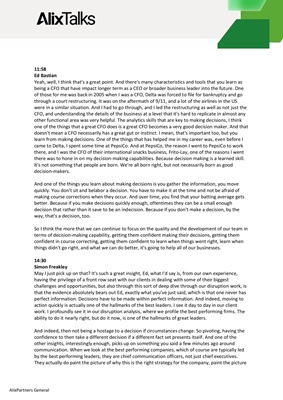
there would be today, in 2023, over five million web designers in the world. Why not? Because there
wasn't a web in 1994. And I think we'll see this with generative AI, we can't imagine how the
workforce will change in nature. I personally am not concerned it will displace labor as a whole. It
will simply redistribute jobs. And as a practical example, I think every business leader is working out
how to redistribute jobs in their enterprise to rise to this challenge.
12:13
Amna Nawaz
Michael, talk about how you're seeing that at the implementation level as well. Those concerns are
real about employment displacement. How are business leaders - you're talking to consumers,
you're talking to, looking at that and what other avenues, what other lanes do you see AI, as you
mentioned, we're already in this. Do you see it being implemented effectively? Revenue or supply
chain? How else are you seeing it already in the works?
12:39
Michael Kratsios
Yeah, I think most of the customers that we interact with are excited about trying to understand
where artificial intelligence can make the biggest impact for their business and do so in sort of the
least strenuous way to get to some sort of answer. And what's sort of been very unique about what's
happened with these LLMs is that the path to implementation now is materially easier than it was
prior to the large language model revolution. So, if you think about a traditional AI deployment,
maybe two, three years ago, it was actually a pretty complicated process. You had to find data. You
had to prepare or annotate data. You had to train a particular model. You'd have to test and
evaluate that model. Then you have to see where it's not working, then go collect more data and go
through this cycle. And this oftentimes was a multi-month or multi-year process.
So, a lot of large enterprises sort of, I think, that attempted to do this, and you probably know this
best with customers you've dealt with in the past. They realized it was an expensive endeavor that
took a really long time. What large language models have allowed now in the industry is for much
quicker implementation. So, these large language models are known as foundation models, and they
are just that. They're a foundation that then you can build on top of with data that you have at your
firm. And what's amazing about these is you can take any natural language, whether it be in PDFs
and emails, in your share drive, and immediately be able to create a customized large language
model for your business.
And because of that, what we're able to do and what others in this space are, you can ultimately get
results for customers in a very short amount of time, in a matter of weeks rather than months or
years. And I think in that sense, you can sort of show to higher level executives and people of the
company that progress is happening. So to me, I think what I'm most sort of excited about is being
able to sort of move through with a variety of customers and show them that you actually can do
something pretty quickly now with AI. And I think that's something that you haven't really
experienced in this space to date.
14:35
Amna Nawaz
Talk to me a little bit more about that speed of the process, though, because as we all know, I mean,
the fine tuning of some of these platforms is where the devil is in those details, right? And we know